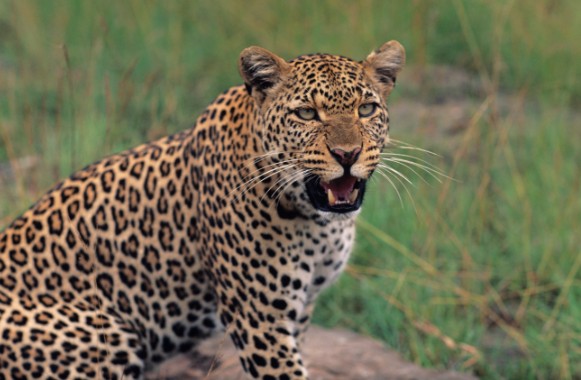Wonders of Creation
Leopard Facts: Habitat, Hunting Skills, and Symbolism in Jewish Thought
Discover the leopard’s strength, night vision, survival in Israel, and its timeless lesson of courage from Chanukah
- Rinat Shahar
- |Updated

The leopard is part of the family of large predatory cats that includes the jaguar, tiger, and cheetah (excluding the lion), but it differs from them significantly in both nature, appearance, and size.
Leopards are found in Africa, the Middle East, and South Asia. Their average weight is about 70 kilograms (sometimes even exceeding 90 kg), its body length can reach up to 1.5 meters, with yellowish-brown color fur, patterned with black spots. Their patterns provide the perfect camouflage, making the leopard hard to detect in dense vegetation.
The leopard’s lifespan in the wild is up to 15 years, but in captivity it can live up to 21 years.
Night Vision and Hunting Abilities
Cats are known as nocturnal hunters, setting out at dusk to stalk prey. To succeed, they possess several unique traits, foremost among them being excellent night vision. The leopard’s eyes are the largest among all carnivores, with pupils that expand widely in the dark, enabling it to see even where other animals grope in total darkness. Its retina is so sensitive that it can detect even the faintest ray of light at night, and the dilation of its pupils creates the familiar greenish glow often seen in cats’ eyes at night.
Like other felines, leopards have extremely sharp hearing. Their ears can pick up the slightest vibrations in the air, alerting them to the faintest movement made by other creatures. Their whiskers function like a radar, sensing changes in the environment.
A Solitary Predator
Leopards live solitary lives. The male hunts mainly mammals such as hares, gazelles, ibex, wild boars, porcupines, and rabbits, and sometimes birds. In South Africa, leopards have even been observed catching fish, especially tilapia and catfish. When prey is scarce, they will also feed on carrion.
Leopards inhabit a variety of environments including forests, deserts, savannas, mountains, and plains. In Israel, they are the largest wild cats. They are primarily nocturnal, though in the cold winter months they may also be active by day. As skilled climbers, they often carry prey into trees to eat undisturbed. After the exertion of the hunt, the leopard rests and eats its meal in peace.
Cubs and Family Life
After a gestation of approximately three months, the female gives birth to one to four cubs (rarely up to six). The cubs weigh about half a kilogram at birth, and are blind and helpless. Their eyes open after about a week, and they nurse from their mother’s milk. By one month, they begin to try eating meat while continuing to nurse until about three months old. At four months, they accompany their mother on hunts.
Although the male lives largely alone, he maintains a connection with the female and protects her from potential threats. The female, however, raises the cubs on her own. When the cubs are about ten days old, she leaves them alone in the den for the first time while she goes hunting, sometimes for several days. She frequently moves them to new hiding places, usually shaded and dense areas, until they are nearly a year old.

Leopards and Humans
In Israel, there are no recorded cases of leopards attacking humans, likely because the Judean Desert and Negev leopards are relatively small and do not attack people. Even in regions where larger leopards live, attacks on humans are rare compared to lions and tigers, which sometimes attack people even when not provoked.
By nature, leopards fear humans. While they may attack prey larger than themselves, when facing a human, they generally retreat — unless they have previously attacked humans. Many cases are recorded of people suddenly encountering leopards face to face without being harmed. The rule in such situations is not to panic. If the leopard has never attacked a human before, it will usually snort loudly and retreat without doing harm. Understandably, one should not test the animal’s patience by provoking it.
The Leopard’s Coat and Poaching
Leopard fur is highly valuable, and it is estimated that thousands of leopards are illegally hunted in Africa each year for their pelts. Because this endangers their survival, international treaties — including those signed by Israel, prohibit the trade in leopard skins.
The Leopard and Chanukah: A Lesson in Courage
The Mishnah in Pirkei Avot teaches: “Be bold as a leopard…” (Avot 5:23). Why the leopard? When a leopard sets its sights on prey, it ignores everything else and focuses solely on its target and attacks fearlessly.
From the story of the Maccabees’ victory over the Greeks, we understand the meaning of this boldness. We say in the Chanukah prayer: “You delivered the mighty into the hands of the weak.” Why call the Jews “weak,” when they fought so bravely?
Jewish strength is not in natural power, but in boldness of spirit — the willingness to fight despite weakness and even when reason suggests defeat.
The lion, king of beasts, symbolizes natural strength and power — the might of the Greek empire. The leopard, bold and daring, symbolizes the Hasmonean kingdom, weaker in worldly terms yet victorious through fearless determination.
The leopard is not the king of animals, but with its irrational boldness, it can even overcome the lion.

